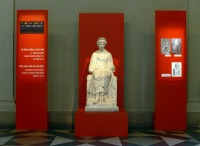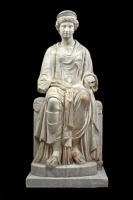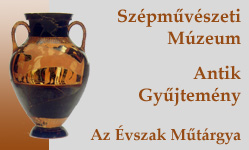The >Juno Enyedi<
Highlighted Works of Art - 2008 Autumn
 |
|
The ancient statue of a seated female figure was initially chiseled from a piece of marble, which was quarried on the north Aegean island of Thasos. Since this kind of marble was exported all over the Mediterranean world during Roman Imperial times, it is not clear where the statue was sculpted and where it was erected. It has been known since 1903 as one of the antiquities in the possession of Lukács Enyedi (1845-1906) in Budapest, whose collection was the source of other ancient objects that found their way into the Museum of Fine Arts. Because it is known that Enyedi bought ancient art in Italy, it is probable that the seated figure originates from there. In 1916 the statue - together with other objects - was offered to the museum, but the then curator Antal Hekler was not interested in this piece since archaeologists at that time preferred to concentrate on the aesthetic and art historical values than on archaeological, social-historical aspects. So the >Juno< stayed in the collection of the family until the estate was sold in 1923, then it disappeared. It resurfaced in the early 1950s, when it decorated the Lukács Bath. In 2008 it came as a long-term loan from the Budapest History Museum to the Museum of Fine Arts, where it has been - a quite difficult enterprise - restored.
 |
|
While the ancient parts - the core of the figure - are made of coarse-grained Thasian marble the many restorations that complement the appearance of the figure consist of (perhaps Italian) fine-grained marble. The biggest areas of post-antique additions are the right shoulder, much of the right leg, the left knee, parts of the throne and its cushion, the front of the plinth, and the rectangular base; in addition, many small parts of the garment folds are restored, and other marble pieces were used to mask breaks. The remaining fragment of the left lower arm seems to have been broken, then reattached. Both hands are now missing, though we can see that the left one was once attached by a dowel. It is not clear whether the head is ancient or a 'modern' addition; it shows an idealized female (i.e., a goddess) with a crown in her hair, and it seems to be a little too small for the body. On the other hand, it is made of the same kind of marble and is not completely worked on the back side, which suggests that it may be an ancient, a bit misproportioned head. Already in antiquity, the original head - together with its neck - was separately worked and connected to the body by fixing it into a rounded cavity on the shoulders. On the other hand, the head is positioned too far to the front, tilted unnaturally far forward - perhaps under the impression of Madonna statues - suggesting a later restoration of three independent parts - head, neck, torso - that originally did not belong to each other, but were joined together by a restorer to produce a >whole< figure.
 |
|
A last technical feature of interest should be mentioned: the appearance of the back side of the statue. The upper area of the body and the left side have been roughly chiseled away, while the whole rest of the statue, the back of the figure and the adjoining throne, carved as one piece, has been for a little bit vertically smoothed with a saw . This differing treatment is puzzling; it may be that the figure once was seated on a high-backed throne, then the back of the throne broke at the edges, and in order to smooth the surface, the remains of the back at the figure's shoulders were chiseled away and the whole backside of the throne hewn down to a plain surface.
 |
|
We see a seated woman, dressed in a chiton (tunic), which is visible only at the decolleté and at the feet, because it is enshrouded by a mantle (a thick, woolen himation), which here wraps around the whole body and covers the breasts. This is unusual; female statues usually wear the mantle loosely, and it normally covers only the lower body and lies as a thick mass of textile in the lap, thus revealing the chiton, usually girt below the breasts. Prototypes for females completely enhulled in a mantle - including the arms - are statues of muses, but these usually are seated on rocks, i.e. they are depicted in the world of nature, outside the house and the polis (a good example is the >Tyche of Antiochia< in the Museum of Fine Arts). Our statue sits on a wooden stool (maybe once even a throne with a high back), which is covered with a thick cushion. Her left arm was outstretched to the front, probably holding an attribute (the holes drilled into the horizontal surface of the left leg may have supported the original attribute or a modern restoration); her right arm is not preserved, so its original position is hard to reconstruct. A similar statue, as well a nearly half-life size figure as the Enyedi piece, found in Bithynia and now in Istanbul, rests her right hand with her arm drawn back on the rear corner of the stool (Mendel III 802). Unfortunately what is left of the upper body of our statue is insufficient to secure such a reconstruction;
 |
|
moreover, the differences in style and chronology (the small statue from Bithynia was worked in the 1st century B.C.) make it difficult to conclude that both statues may derive from a common model. If our statue was seated on a stool, then it is likely that the figure once decorated the tomb of a Roman lady. In this case, the head would have been not an idealized one (as we see it today), but an individual portrait of the deceased; the body would have depicted her in the guise of a goddess (consecratio in formam deorum). If - on the other hand - we reconstruct a female figure on a throne with a high back and an idealized head, such as the one that currently crowns the figure, then we should interpret the statue as the depiction of a goddess; but which deity was intended can no longer be established since all indicative attributes are lost. If it does depict a goddess, the seated position on a throne points toward a >mother goddess<, such as Juno or Demeter, but we cannot exclude an Imperial personification, such as Fecunditas (fertility).
The style of workmanship with the shallow mantle folds and relatively infrequent long-channeled drilling in the chiton (as well as in the hair) dates this marble statue to the early decades of the second century A.D.
Hans Rupprecht Goette





